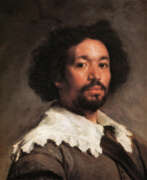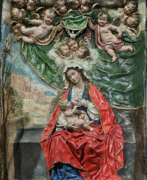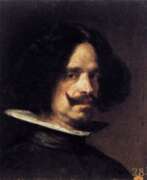Spanish Golden Age 17th century


Juan de Pareja was a Spanish painter and slave, born in Antequera, near Málaga, Spain. He is known primarily as a member of the household and workshop of painter Diego Velázquez, who freed him in 1650. His 1661 work The Calling of Saint Matthew (sometimes also referred to as The Vocation of Saint Matthew) is on display at the Museo del Prado in Madrid, Spain.


Luisa Ignacia Roldán Villavicencio, known as La Roldana, was a Spanish sculptress of the Baroque period and the first female sculptor in Spain about whom there is verified lore. In the Museum of the Latin American Society, Roldán is described as "one of the few female artists who had their own workshop outside the convent in Golden Age Spain". Her father Pedro Roldán was also a sculptor from Seville.


Diego Velázquez, a seminal figure in the history of Western art, was a Spanish painter whose work left an indelible mark on the canvas of art history. Born in Seville, Spain, in 1599, Velázquez's early life was steeped in the rich cultural heritage of his homeland, which would later profoundly influence his artistic direction. His baptism took place in the church of St. Peter in Seville, hinting at a life that would be closely intertwined with the spiritual and cultural fabric of Spain.
Velázquez's journey into art began under the tutelage of Francisco Pacheco, a renowned artist in Seville, where he honed his skills and developed a unique style that married realism with a keen observation of human nature. This formative period was crucial, setting the stage for Velázquez to become the leading artist in the court of King Philip IV, where he produced portraits that captured the essence of the Spanish royal family with unparalleled depth and sensitivity. His work during this period, including iconic pieces like "Las Meninas" and "The Surrender of Breda," showcased not only his technical prowess but also his ability to convey complex narratives and emotions through his paintings.
Velázquez's influence extended far beyond his lifetime, inspiring future generations of artists across various movements. His approach to realism and use of light and shadow would later become a cornerstone for realist and impressionist painters in the 19th century, including Édouard Manet. Moreover, 20th-century icons like Pablo Picasso, Salvador Dalí, and Francis Bacon paid homage to Velázquez, reinterpreting his works and celebrating his enduring legacy in the canon of art history.
The breadth of Velázquez's work is best appreciated in institutions like the Museo del Prado in Madrid, which houses an extensive collection of his paintings. These pieces not only offer a glimpse into the artist's mastery over his medium but also reflect the cultural and historical zeitgeist of 17th-century Spain. Velázquez's ability to capture the human condition, coupled with his innovative techniques, cemented his position as a pivotal figure in the Baroque period and a master of the Spanish Golden Age of painting.
For collectors and experts in art and antiques, Velázquez's oeuvre represents a pinnacle of artistic achievement, offering insights into the evolution of painting and the enduring power of visual storytelling. His works continue to inspire and captivate audiences, underscoring the timeless nature of his artistry.
To stay informed on new discoveries, product sales, and auction events related to Diego Velázquez, signing up for updates is highly recommended. This ensures that enthusiasts and collectors alike remain connected to the vibrant world of Velázquez and the rich heritage of Spanish art.

